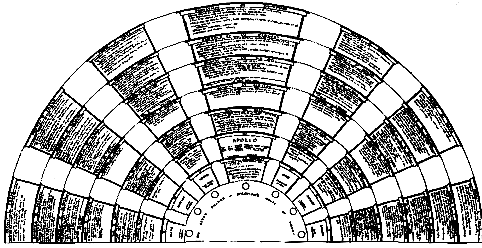

Giulio Camillo Delmino was one of the most famous thinker in the sixteenth century, however he had been completely forgotten by the eighteenth. His claim to such a transitory fame lies in his construction of a Memory Theater, of which only a short, eighty-seven page book, L'idea del Theatro (1550), explaining its construction and function remains. This theatre was a wooden structure which was first presented in Venice and then in Paris, and was the talk of Europe at the time.
Various accounts describe the structure as a building which would allow one or two individuals at a time within its interior. The insides were inscribed with a variety of images, figures, and ornaments. It was full of little boxes arranged in various orders and grades. Upon entering the Theater, the spectator will be able to discourse on any subject no less fluently than Cicero [1] as he stands on a stage looking out towards the auditorium where the images are placed among seven pillars or grades. Each grade representing the expanding history of divine thought. In the first grade there were the 'seven essential measures' depicted by the 'seven known planets' which were the First Causes of creation and from which all things depended. The highest grade of the Theatre was the seventh level, which was assigned to all the arts, 'both noble and vile,' and is represented by Prometheus who stole the technology of fire from the gods.
Camillo had transformed the Art of Memory into a practical means for construction. Frances A. Yates writes of this transformation: .
The emotionally striking images of classical memory, transformed by the devout Middle Ages into corporeal similitudes, and transformed again into magically powerful images. The religious intensity associated with mediaeval memory has turned in a new and bold direction. The mind and memory of man is now 'divine', having powers of grasping the highest reality through a magically activated imagination [2].
Camillo never finish his Memory Theatre, nor did any of his constructions survive to the seventeenth century. Yet the attempt was felt. In her book, Theatre of the World, Yates points towards the construction of the Globe Theatre in Shakespeare's day, of having been the result of Camillo's influence through the works of two Elizabethan hermetic philosophers and magi, John Dee and Robert Fludd. A copy of Camillo's L'Idea del Theatro was in Dee's famous library, and undoubtedly known among the learned in England at the time [3].
One also wonders what the connection between these ideas and the Kunst- und Wunderkammern of the sixteenth and seventeenth century might be? The 'wonder-cabinets' of this period were eclectic collections of oddities, which displayed man-made objects inspired by the new sensibilities of science and contemporary works of art along side with curious and exotic objects of natural history (often from the New World), and supposed relics of religious significance, folklore and antiquity. The 'wonders of God' were systematically arrayed with the 'wonders of man' and arranged in a cabinet or tableaux: the examination of which, would shock the viewer into a new conception of reality and wonder for the divine expressions of God. Three hundred and some odd years later, the collages of Cubism, Futurism and Dada would have a similar effect and wake the viewer up to a new artistic reality of space and time.
These early, esoteric collections evolved into larger displays which were prototypical to the modern museums which emerged in the nineteenth century. The Theatrum Anatomicum in Leiden in 1590 for example, housed a large array of skeletons arranged in a circular amphitheater, that were re-articulated to depict moral lessons from the Bible. In other Wunderkammern of the era, were arranged all sorts of curiosities such as pieces of the ark of Noah, rhinoceros horns, mechanical devices which appeared animated, shrunken heads, Madonnas made from feathers, Javanese costumes, elephant's teeth, etc., any sort of object which would suggest unfamiliarity. They would capture the eye and the imagination by being placed out of context and in a pre-Linnean order to accent their strangeness [4].
References:
1. Francis A. Yates, The Art of Memory (Chicago: The University of Chicago Press, 1966), pp. 130-131.
2. ibid, p. 157.
3. Francis A. Yates, Theatre of the World (Chicago: The University of Chicago Press, 1969).
4. An entertaining study of a modern Wunderkammern with references to the vintage representations, can be found in Lawrence Weschler's Mr. Wilson's Cabinet of Wonder: Pronged Ants, Horned Humans, Mice on Toast, and Other Marvels of Jurassic Technology (New York: Pantheon Books, 1995). The next step in Wunderkammern is the World Wide Web, and for which the Museum of Jurassic Technology has a site.